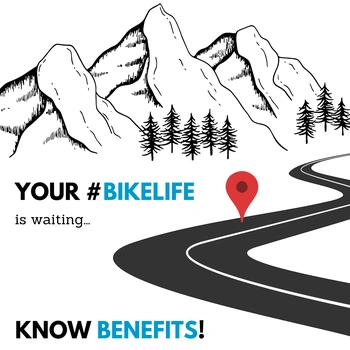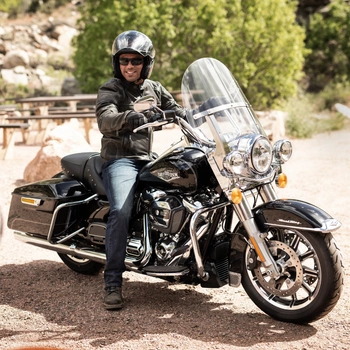
As fuel is getting expensive each day, it becomes much more important to keep track of your bike's or vehicle's fuel consumption. The mileage of a bike is one of the main concerns while investing in a bike. It's recommended to at least monthly check your bike's Mileage or how much fuel it consumes. The average mileage of a bike is just one indicator of its on-road condition. Theoretically, a vehicle that has covered more miles has more wear and tear, but a bike with 40,000 miles on the odometer can easily be in worse shape than one with 60,000 miles. Still, when it comes to getting more from your vehicle, the odometer reading is usually the first thing owners check.
Table Of Contents:
How can I check my bike's Mileage?
When your bike's fuel consumption increases, there can be some issues with your motorcycle, and some may be more significant, such as defective spark plugs or clogged fuel. The reason could also be your riding, braking or aggressive throttling style. Whatever the reason, calculating the Mileage of your bike is one of the good things to do, and there are multiple ways to do that. We have picked up three ways to figure your bike's Mileage with simple formulae and also the measure of accuracy you may get with it.
How to find the average bike mileage?
The fundamental formula for calculating Mileage in KMPL is Distance travelled in Kms / Amount of fuel used in litres.
For example, if you ride your bike for 100 km with 5 litres of fuel, the Mileage of your bike is 100km/5 litre, i.e., 20 km per litre.
Now, we will use this same formula with three different setups.
Full Tank Method
In this first method, you must fill the bike's fuel tank to its full capacity and reset the trip meter to 0. Now ride your bike for 100 km and again refill the tank. Repeat this process 2-3 times and note the amount of fuel filled in litres every time. Now, apply the above formula (100/litre) to each fuel notation and calculate the respective Mileage.
You may find a difference in these notations; their average will give you a fair idea of the bike's Mileage. This method is the most common method to determine the bike's Mileage but it does not provide accurate results as determining whether the tank is full or not is not surely confirmed (as air pockets often get formed in your fuel tank while filling).
Mileage Testing Bottle Method
 This method uses a mileage measuring bottle that is directly attached to the carburetor hanging through the handlebar or taped to the fuel tank.
This method uses a mileage measuring bottle that is directly attached to the carburetor hanging through the handlebar or taped to the fuel tank.
Here, the fuel pipe to the carburettor is attached with the measuring bottle with fuel (say 500 ml) in it, the trip meter is set to 0, and the bike is made to run until the fuel in this bottle reaches 100 ml. The trip meter is noted down and divided by 0.4 litres or whatever amount you used. This final reading gives the Mileage of the bike.
This method is pretty accurate and only depends on the driving condition you had when you measured, so be in your normal riding mode.
Reserve Filling Method
This method involves the reserve switch or reserve digital indication of your fuel tank when the fuel is about to reach its reserve notation. When your bike turns into a reserve position, reset the trip meter to 0 or mark the odometer reading.
Let us assume the odometer reading at this point is 2000 Km. Now at this point, fill the tank with, say, 1 litre of fuel (pre-filled bottle). Ride your bike till it again comes to the reserve position. Let us say at this point that the bike has covered 2050 km. Calculate the difference between the final and initial odometer reading, which comes out to be 50 (2050 - 2000) km. This 50 km is covered in 1 litre of fuel. Hence the Mileage here comes out to be 50km/litre.
The only issue with this method is that we are not entirely known to the exact structure of the fuel tank and fuel position on both sides of the chassis rod when the bike comes to reserve. This method, too, requires taking approximately 3-4 sets of readings to draw a conclusive mileage.
Boost Your Motorcycle's Mileage with These Pro Tips
Whether you're a daily commuter or a weekend warrior, fuel efficiency is a crucial aspect of motorcycle riding that can save you money and enhance your riding experience. Combining expert advice from our latest videos, here's a comprehensive guide to getting the best mileage out of your motorcycle.
Regular Maintenance: The Foundation of Efficiency
Maintaining your motorcycle in top condition is the bedrock of fuel efficiency. Regular servicing, including timely oil changes, checking valve gaps, and replacing the coolant, ensures your engine runs smoothly and efficiently. A well-maintained bike uses fuel more effectively and reduces unnecessary power loss.
Fuel Management
To start, always opt for fuel from a reputable station and try to keep your tank at least 70% full to minimize vapor losses. Regularly checking your fuel levels by refilling from the same pump and calculating mileage over consistent distances can provide a true measure of your bike's fuel consumption.
Engine and Gear Management
The way you handle your bike's engine and gears can significantly impact fuel efficiency:
- Throttle Control: Accelerate gently. Aggressive starting and stopping consume more fuel. Aim for smooth throttle transitions.
- Gear Shifting: Use gears wisely—shift up before the engine strains and down when you need more power without throttling hard. Keeping your RPMs within the power band (ideally between 3,000 and 4,000 RPMs) optimizes fuel consumption.
- Engine Braking: Anticipate stops and let engine braking slow you down before applying the brakes. This practice not only saves fuel but also reduces brake wear.
Riding Practices
How and where you ride also plays a significant role in fuel efficiency:
- Speed: Maintain a steady speed; constant acceleration and deceleration sap fuel. The optimal speed for fuel efficiency usually ranges around 50-65 km/h depending on your bike model and conditions.
- Wind Resistance: High speeds increase wind resistance, which in turn requires more power. Riding at moderate speeds reduces this effect.
Other Considerations
- Tire Pressure: One of the most overlooked aspects of motorcycle maintenance is tire pressure. Incorrect tire pressure can drastically reduce mileage. Check it weekly.
- Chain Maintenance: Ensure your chain is clean, well-lubricated, and properly adjusted. A dirty or tight chain creates friction, increasing fuel consumption.
- Use of Accessories: Minimize the use of non-essential electrical accessories, such as additional lights and horns, which place extra load on the alternator and engine.
FAQs
How frequently should I get my bike's Mileage checked?
There is no set time duration after which you should check your bike's mileage. However, the general recommendation is to have it done at least once a year or more often if you ride frequently.
What is mileage in Bike
Mileage in the context of a motorcycle refers to the fuel efficiency of the bike, usually measured in terms of how many kilometers or miles it can travel per liter or gallon of fuel. It reflects how economically a motorcycle uses fuel, and higher mileage means the bike can travel further on the same amount of fuel, which can lead to cost savings on gas and reduced environmental impact. Mileage is influenced by several factors including the bike's engine efficiency, maintenance, riding style, and the conditions under which the bike is used.
How can I improve my bike's Mileage?
If you're looking to improve your bike's mileage, you can do a few things. First, make sure your tires are properly inflated. This will help reduce rolling resistance and improve fuel efficiency. Second, avoid excessive idling. If you're going to stop for more than a minute or two, it's best to turn off your engine to save fuel. Finally, try to maintain a consistent speed when you're riding. Varying your speed too much can lead to decreased mileage.






